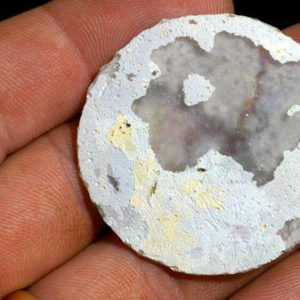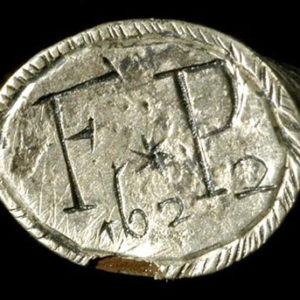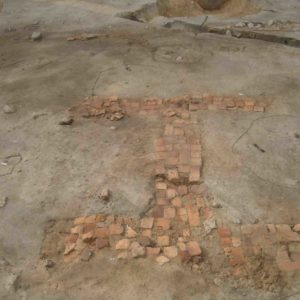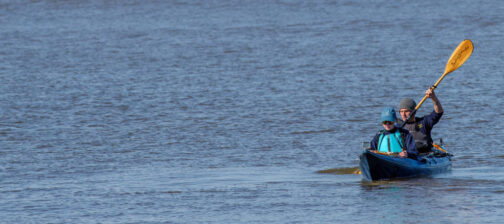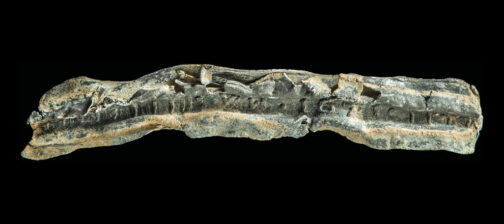After months of digging, Jamestown Rediscovery archaeologists have almost finished excavating the remains of a long building with a cobblestone foundation that may have been the governor’s house or a residence for high ranking colonists, according to William Kelso, APVA director of archaeology.
Known as Structure 172, the building was 167 feet long and 18 feet wide, a width that fits traditional James Fort Period dimensions, and may have been similar in form to a London rowhouse or almshouse. The foundation is about 10 feet away from and parallel to the west wall of the James Fort site, which is the same as other early structures that have been unearthed inside the fort site, so it was probably built sometime between 1607 and 1622, when the fort was in use.
Archaeologists have also uncovered four H-shaped hearths inside the building that divide it into eight to ten rooms, and there is a cluster of cobblestones near the center of the building that archaeologists are currently excavating that may relate to another hearth, but doesn’t make sense, yet. They also recently uncovered the remains of floor joists and nails in the end room, near the north corner of the fort site.
Based on what they know so far about the building and a written reference that was discovered by Bly Straube, APVA curator, Kelso said it may be the house that was built in 1611 for Thomas Gates when he was governor. According to a reference in the Virginia Company Records, written in November 1618, future governors enlarged and continued to use Gate’s house as their residence:
“And we do hereby ordain that the Governors house in James town first built by Sir Thomas Gates Knight at the charges and by the Servants of the Company and since enlarged by others by the very same means be and continue forever as the Governors house…”
Archaeologists recently found a brick foundation that was added to the north end of the cobblestone building, so Kelso said the possibility that this was the governor’s house and the archaeological evidence are beginning to match up.
The only artifact that has been found so far to help date the building is Bermuda limestone that was used in the construction of one of the hearths. The earliest date that Bermuda limestone could have been in the colony is the spring of 1610 when colonists who had been shipwrecked for a year in Bermuda, finally arrived at Jamestown. Bermuda limestone was proclaimed by the colonists to be very good ballast, and they may have used it in the new ship they built to reach Jamestown. That tells archaeologists that the building could have been constructed no earlier than the spring of 1610.
Currently archaeologists are unearthing the center of the building which is under a large mound of dirt that may have been a bomb shelter during the Civil War. As earth is removed, every layer, feature and artifact is carefully recorded to document the Confederate Fort from the 19th century as well as the 17th-century James Fort.
After they finish unearthing the foundation of the cobblestone building, archaeologists will excavate the builder’s trench around the cobblestones. This may yield artifacts dropped in the trench during the construction period that will help further date when the building was constructed.
The building also cuts across several small pits that were there before the building was constructed. These will also be excavated and any artifacts found in the fill will help date the time period that the pits were in use. Archaeologists will then know that the building was constructed after the latest date associated with the pits.
Artifacts discovered above and around the building seem to include a relatively high concentration of status items compared to other areas of the fort site such as broken Chinese porcelain wine cups, ceramics and glassware in the facon de Venise. Archaeologists have also discovered the lens of an early telescope, a 1605 Bartmann jug medallion, and pieces of delftware wall tiles, probably from the second quarter of the 17th century. Personal objects such as a small silver wax seal with a scallop shell design, a silver putto, a crucifix made of jet, the cap of the handle of a small silver knife engraved with the initials FP and the date 1622, and other items such as buttons, aglets, oyster shells and food remains have also been found in this area.
These artifacts were mixed up in the soil that was deposited above the building site during the construction of the Civil War fort and cannot be used to date the building, but they may indicate that this end of the fort was where high-ranking colonists lived. The difference in the architecture at this end of the fort, compared to the earth fast mud and stud structures found at the other end of the fort, and the difference in artifacts may also indicate a social class separation in the overall design of the fort.
Archaeologists will continue digging into the winter months until the ground freezes, as long as the weather permits.
related images
- 17th-Century telescope lens
- Cap of silver knife with FP initials and 1622 date
- Hearth in Structure 172



